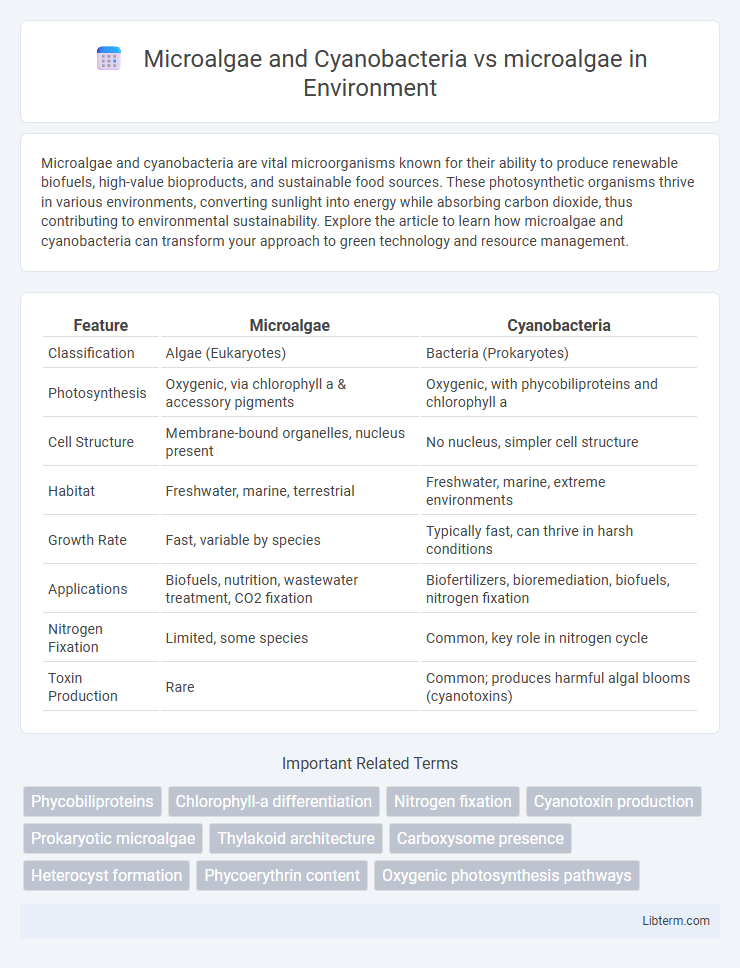Microalgae and cyanobacteria are vital microorganisms known for their ability to produce renewable biofuels, high-value bioproducts, and sustainable food sources. These photosynthetic organisms thrive in various environments, converting sunlight into energy while absorbing carbon dioxide, thus contributing to environmental sustainability. Explore the article to learn how microalgae and cyanobacteria can transform your approach to green technology and resource management.
Table of Comparison
| Feature | Microalgae | Cyanobacteria |
|---|---|---|
| Classification | Algae (Eukaryotes) | Bacteria (Prokaryotes) |
| Photosynthesis | Oxygenic, via chlorophyll a & accessory pigments | Oxygenic, with phycobiliproteins and chlorophyll a |
| Cell Structure | Membrane-bound organelles, nucleus present | No nucleus, simpler cell structure |
| Habitat | Freshwater, marine, terrestrial | Freshwater, marine, extreme environments |
| Growth Rate | Fast, variable by species | Typically fast, can thrive in harsh conditions |
| Applications | Biofuels, nutrition, wastewater treatment, CO2 fixation | Biofertilizers, bioremediation, biofuels, nitrogen fixation |
| Nitrogen Fixation | Limited, some species | Common, key role in nitrogen cycle |
| Toxin Production | Rare | Common; produces harmful algal blooms (cyanotoxins) |
Introduction to Microalgae and Cyanobacteria
Microalgae and cyanobacteria are both photosynthetic microorganisms but differ significantly in their cellular structure and evolutionary origin; microalgae are eukaryotic organisms with complex cellular compartments, while cyanobacteria are prokaryotic bacteria that perform oxygenic photosynthesis. Microalgae encompass diverse groups such as diatoms, green algae, and dinoflagellates, playing crucial roles in aquatic ecosystems and carbon fixation. Cyanobacteria contribute to nitrogen fixation in addition to photosynthesis, enabling their survival in nutrient-poor environments and making them key players in global biogeochemical cycles.
Defining Microalgae: Characteristics and Diversity
Microalgae encompass a diverse group of photosynthetic microorganisms, including both eukaryotic microalgae and prokaryotic cyanobacteria, characterized by their ability to convert sunlight into biochemical energy. Eukaryotic microalgae possess membrane-bound organelles, such as chloroplasts, while cyanobacteria, often termed blue-green algae, lack these structures but similarly perform oxygenic photosynthesis. This diversity spans multiple phyla, with microalgae playing critical roles in aquatic ecosystems, carbon cycling, and biotechnological applications such as biofuel production and nutraceuticals.
Understanding Cyanobacteria: Unique Features
Cyanobacteria, often classified under microalgae, possess unique photosynthetic pigments like phycobiliproteins that differentiate them from true microalgae, such as green algae. These prokaryotic organisms exhibit nitrogen-fixing capabilities through specialized cells called heterocysts, enabling them to thrive in nutrient-poor environments. Their ability to form harmful algal blooms and produce bioactive compounds highlights their ecological and biotechnological significance.
Phylogenetic Relationships: Microalgae vs. Cyanobacteria
Microalgae and cyanobacteria exhibit distinct phylogenetic relationships, with microalgae belonging to diverse eukaryotic lineages and cyanobacteria classified as prokaryotic bacteria. Cyanobacteria are considered among the earliest photosynthetic organisms, contributing to the origin of chloroplasts through endosymbiosis in eukaryotic microalgae. Phylogenetic studies reveal that microalgae have multiple evolutionary origins, whereas cyanobacteria form a monophyletic group within the bacterial domain.
Habitat and Ecological Roles
Microalgae inhabit diverse aquatic environments including freshwater, marine, and extreme habitats, while cyanobacteria thrive in similar niches but uniquely colonize terrestrial and extreme conditions like deserts and hot springs. Both microalgae and cyanobacteria play crucial ecological roles by contributing significantly to global primary production and oxygen generation through photosynthesis. Cyanobacteria uniquely fix atmospheric nitrogen, enhancing nutrient availability and supporting aquatic food webs, whereas microalgae contribute to carbon sequestration and serve as foundational species in aquatic ecosystems.
Photosynthetic Mechanisms and Pigmentation
Microalgae and cyanobacteria exhibit distinct photosynthetic mechanisms, with microalgae primarily utilizing chlorophyll a and accessory pigments like chlorophyll b and carotenoids, while cyanobacteria rely on phycobiliproteins such as phycocyanin and phycoerythrin for light capture. The photosystems in cyanobacteria resemble those in higher plants but are embedded in thylakoid membranes differently, enabling efficient energy transfer through phycobilisomes. These pigment differences contribute to their unique light absorption spectra, optimizing photosynthesis across diverse aquatic environments.
Industrial Applications: Microalgae and Cyanobacteria
Microalgae and cyanobacteria offer distinct advantages for industrial applications due to their diverse biochemical compositions and rapid growth rates. Microalgae are extensively used in biofuel production, nutraceuticals, and wastewater treatment because of their ability to accumulate lipids, proteins, and pigments like chlorophyll and carotenoids. Cyanobacteria contribute to sustainable agriculture through nitrogen fixation and are utilized in bioplastics and pharmaceutical sectors owing to their production of bioactive compounds such as phycocyanin and polysaccharides.
Nutritional Profiles and Bioactive Compounds
Microalgae and cyanobacteria exhibit distinct nutritional profiles, with microalgae generally rich in proteins, essential fatty acids, vitamins, and minerals, while cyanobacteria like Spirulina are particularly high in phycocyanin and antioxidants. Both sources provide significant bioactive compounds such as polysaccharides, pigments, and phenolic compounds, contributing to their anti-inflammatory, antiviral, and immune-boosting properties. The diversity in lipid content and pigment concentration differentiates their applications in nutraceuticals and functional foods, emphasizing microalgae's omega-3 fatty acids versus cyanobacteria's unique phycobiliproteins.
Environmental Impact and Sustainability
Microalgae and cyanobacteria both contribute significantly to environmental sustainability by efficiently capturing carbon dioxide and producing oxygen through photosynthesis, with microalgae generally demonstrating higher biomass productivity rates. Cyanobacteria possess unique nitrogen-fixing abilities, reducing the need for synthetic fertilizers and enhancing soil health in ecosystems. Their rapid growth and minimal resource requirements position both organisms as sustainable solutions in biofuel production and wastewater treatment, lowering environmental footprints compared to traditional agricultural practices.
Comparative Summary: Microalgae vs. Cyanobacteria
Microalgae and cyanobacteria both contribute significantly to aquatic ecosystems through photosynthesis, but microalgae are eukaryotic organisms with complex cellular structures, whereas cyanobacteria are prokaryotic and lack membrane-bound organelles. Microalgae include diverse groups such as diatoms, green algae, and dinoflagellates, often producing high-value compounds like omega-3 fatty acids, while cyanobacteria are known for nitrogen fixation and production of bioactive substances like phycocyanin. In terms of applications, microalgae are widely used in biofuel production, nutraceuticals, and wastewater treatment, whereas cyanobacteria are prominent in soil fertility enhancement and as natural sources of antioxidants and pigments.
Microalgae and Cyanobacteria Infographic

 libterm.com
libterm.com